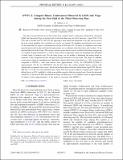GWTC-2: Compact Binary Coalescences Observed by LIGO and Virgo during the First Half of the Third Observing Run
Author(s)
LIGO Scientific Collaboration; Virgo Collaboration
DownloadPublished version (3.918Mb)
Publisher with Creative Commons License
Publisher with Creative Commons License
Creative Commons Attribution
Terms of use
Metadata
Show full item recordAbstract
We report on gravitational wave discoveries from compact binary coalescences
detected by Advanced LIGO and Advanced Virgo in the first half of the third
observing run (O3a) between 1 April 2019 15:00 UTC and 1 October 2019 15:00. By
imposing a false-alarm-rate threshold of two per year in each of the four
search pipelines that constitute our search, we present 39 candidate
gravitational wave events. At this threshold, we expect a contamination
fraction of less than 10%. Of these, 26 candidate events were reported
previously in near real-time through GCN Notices and Circulars; 13 are reported
here for the first time. The catalog contains events whose sources are black
hole binary mergers up to a redshift of ~0.8, as well as events whose
components could not be unambiguously identified as black holes or neutron
stars. For the latter group, we are unable to determine the nature based on
estimates of the component masses and spins from gravitational wave data alone.
The range of candidate events which are unambiguously identified as binary
black holes (both objects $\geq 3~M_\odot$) is increased compared to GWTC-1,
with total masses from $\sim 14~M_\odot$ for GW190924_021846 to $\sim
150~M_\odot$ for GW190521. For the first time, this catalog includes binary
systems with significantly asymmetric mass ratios, which had not been observed
in data taken before April 2019. We also find that 11 of the 39 events detected
since April 2019 have positive effective inspiral spins under our default prior
(at 90% credibility), while none exhibit negative effective inspiral spin.
Given the increased sensitivity of Advanced LIGO and Advanced Virgo, the
detection of 39 candidate events in ~26 weeks of data (~1.5 per week) is
consistent with GWTC-1.
Date issued
2021Department
LIGO (Observatory : Massachusetts Institute of Technology); Massachusetts Institute of Technology. Department of Physics; MIT Kavli Institute for Astrophysics and Space ResearchJournal
Physical Review X
Publisher
American Physical Society (APS)
Citation
2021. "GWTC-2: Compact Binary Coalescences Observed by LIGO and Virgo during the First Half of the Third Observing Run." Physical Review X, 11 (2).
Version: Final published version